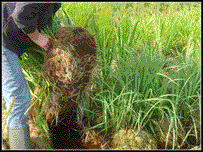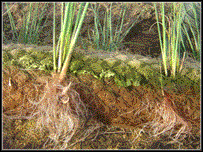A New Embankment at Foss Dyke
27 Feb 2006
 Ever mindful of the environmental issues surrounding the railway, Network Rail has commenced work in Lincolnshire on a five month project to repair part of the embankment between the railway and the Foss Dyke canal. This project forms part of Network Rail’s LNE Territory Structures and Earthworks Framework Contract, which is being handled by main contractor May Gurney Rail.
Ever mindful of the environmental issues surrounding the railway, Network Rail has commenced work in Lincolnshire on a five month project to repair part of the embankment between the railway and the Foss Dyke canal. This project forms part of Network Rail’s LNE Territory Structures and Earthworks Framework Contract, which is being handled by main contractor May Gurney Rail.
The embankment has significantly eroded over the years, and an environmental team from May Gurney Rail Services has come in to restore and strengthen the banking, taking into account the potential for wildlife in the area.
An extensive environmental checklist
The wooden pilings which reinforce the embankment have either worn away or disappeared, and in October last year May Gurney was invited to the site to review and assess the damage, and plan what would be needed to remedy it. For this they used an extensive environmental checklist, the original ecological survey of the area, and a detailed map.
As soon as the team had completed their initial studies, a further investigation of the embankment was made once better access to it had been secured from the canal side. May Gurney and sub-contractor Salix River and Wetland Services Ltd., audited the area to look for presence of fauna, particularly water voles, before proceeding. Whilst none were found, kingfishers and their nests were, and as they are a protected species careful consideration will be made during the works to ensure their breeding areas are not disturbed, with the kingfisher eggs set to be laid in April and May, with hatching by the end of July.
Reinforcement of the embankment
The works involve the removal of trees and vegetation, and reinforcement of the embankment. Two 1.8 metre stakes will be driven into the canal bed. On the bed dead willow faggots will be laid to guard against erosion of the towe of the embankment by water. This is a busy area, with a new marina nearby causing increased boating activity on the canal. There will also be sheet piles, behind which will be various types of strengthening material.
 Salix will place pre-established coir rolls on top of the dead Willow faggots. The faggots are used to bring the coir rolls up to the correct level and will remain indefinitely under water without rotting due to the anaerobic conditions. The coir rolls with aquatic plants throughout will form the living element of the revetment at water level. This organic revetment technique is being used as a direct alternative to sheet piling on certain areas of the project. The coir used is Fair trade coir from a sustainable source. The high lignin (wood) content copes well with wave action and fast flows. Degradation period of coir depends on site conditions and biological activity. it should last up to five years in water. The polypropylene casing holding the coir within the rolls is non degradable. By the time the coir fibre has degraded, the plant roots and shoots will have formed a dense mass with the polypropylene netting adding to the inherent strength as the roots bind throughout it. At Foss Dyke, the coir will be installed in rolls.
Salix will place pre-established coir rolls on top of the dead Willow faggots. The faggots are used to bring the coir rolls up to the correct level and will remain indefinitely under water without rotting due to the anaerobic conditions. The coir rolls with aquatic plants throughout will form the living element of the revetment at water level. This organic revetment technique is being used as a direct alternative to sheet piling on certain areas of the project. The coir used is Fair trade coir from a sustainable source. The high lignin (wood) content copes well with wave action and fast flows. Degradation period of coir depends on site conditions and biological activity. it should last up to five years in water. The polypropylene casing holding the coir within the rolls is non degradable. By the time the coir fibre has degraded, the plant roots and shoots will have formed a dense mass with the polypropylene netting adding to the inherent strength as the roots bind throughout it. At Foss Dyke, the coir will be installed in rolls.
Prior to the start of the bird-nesting season
Brushwood backfill, comprised of material recycled from overhanging trees and imported willow, is to occupy the areas up the staked embankment, on top of which will be placed a pallet with mature marginal plants grown in. More brushwood is to then be laid on top of this, held in place with tied-down wire. All this will be done prior to the start of the bird-nesting season.
Eventually, the embankment will be totally active in plant and animal species. The plants will take hold and knit together to create a wildlife haven for years to come.
